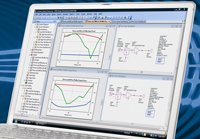Version 2009 of Microwave Office® Design Software

Includes patent-pending Multi-Rate Harmonic Balance (MRHB™) simulation technology that speeds design of complex circuits
El Segundo, Calif. — July 20, 2009 — AWR, the innovation leader in high-frequency electronic design automation (EDA), today announced Version 2009 of its Microwave Office design suite. The latest release of AWR's flagship product features new MRHB technology that dramatically increases the speed and reduces the computer memory required to perform steady-state analysis of complex nonlinear systems with multiple signal sources.
"MRHB satisfies the needs of our customers to perform steady-state analysis of distributive or dispersive systems with more than two or three signal sources," said Taisto Tinttunen, chief director of engineering of AWR’s APLAC division, who explained the limitation of previous tools and the significance of MRHB. "Harmonic-balance engines traditionally do not scale well as the number of tones increases, so simulating a complete receiver or high-speed digital circuit was extremely difficult or impossible because of the high computational cost of nonlinear model evaluations and the extensive memory utilization.”
“MRHB eliminates this limitation by defining harmonic balance analysis on a block-by-block basis,” Tinttunen continued, “ reducing filtered sources and their harmonics by defining new hybrid tones based on linear combinations of the source tones. As a result, AWR’s MRHB technology makes it possible to simulate designs that were previously beyond the reach of the harmonic balance technique, and provides a 5x speed increase when simulating large, complex multi-tone designs.”
Microwave Office Version 2009 includes a wide array of new features as well, including:
• Expanded support for Open Access (OA) Process Design Kits (PDKs)
As a founding member of the Interoperable PDK Library (IPL) alliance, AWR supports OA PDKs and layout views that enable an interoperable design flow among EDA vendors. They facilitate the seamless exchange of design information between software vendors, foundry partners, and their customers by employing a standard format.
• Constant output power simulation
Many power-related measurements are better specified and analyzed when output power is set to a fixed level rather than varying the input power and manually using the measurement "search" function to determine required output power. This new capability within Microwave Office software eliminates manual, post-processing steps and reduces simulation iterations.
• Enhanced load-pull analysis
The Microwave Office software environment effectively handles data formats from device characterization specialists Maury Microwave and Focus Microwaves. Enhancements to the software’s load-pull analysis, as requested by AWR customers, include dramatic speed improvements as well as the ability to add or remove load-pull data points directly on the Smith Chart.
• Behavioral model support for Mesuro's active load-pull system
Mesuro’s active load-pull system and “Waveform Engineering,” pioneered at Cardiff University, enable the replication of S-parameter concepts within the nonlinear domain. This complete solution simultaneously measures the actual current and voltage at a device under test, allowing designers to view and engineer their waveforms to match theory. From this, a behavioral model, called a "Cardiff model", can be extracted and invoked within Microwave Office Design Environment 2009. As a result, modeling and design engineers can fully characterize their devices or power-amplifiers for any signal and impedance environment.
• Customizable project tree that can reconfigure nodes to allow better organization of large projects supporting hundreds of schematics and graphs.
In addition to these major enhancements, Version 2009 of Microwave Office software includes dozens of other subtle improvements throughout the design environment that increase productivity and enrich the user experience. To learn more, visit www.awrcorp.com/mwo, and AWR.TV.
Availability
Microwave Office Version 2009 in currently in beta-release at selected AWR customers and will be commercially available in Q3/Q4 2009.
